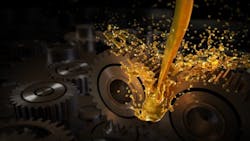Maintenance Mindset: How air and water contamination undermine industrial lubrication systems
Welcome to Maintenance Mindset, our editors’ takes on things going on in the worlds of manufacturing and asset management that deserve some extra attention. This will appear regularly in the Member’s Only section of the site. This week's column features guest contributor Michael D. Holloway, President of 5th Order Industry.
Air and water are fundamental to sustaining life, yet within the realm of industrial lubrication, they represent two of the most insidious contaminants. Both compromise the very purpose of lubrication: to separate moving surfaces, control temperature, and protect against wear and corrosion. Their presence, though often invisible or underestimated, can compromise lubricant performance, accelerate equipment failure, and erode reliability gains painstakingly achieved through design and maintenance best practices.
Their ingress into lubricating systems is inevitable without vigilant design, operational discipline, and maintenance practices, and we must treat air and water management as a core aspect of asset health strategies.
Managing air contamination in lubrication systems: types, risks, and maintenance solutions
Dissolved air. In lubricated systems, air enters in multiple forms. Dissolved air exists at the molecular level within the oil, and remains harmless under stable conditions. However, when system pressures drop suddenly, such as at pump suction inlets, the air can come out of solution rapidly, leading to cavitation. Cavitation generates localized micro-jetting forces that pit metal surfaces, degrade bearings, and damage pump internals.
Entrained air. Entrained air appears as microscopic bubbles dispersed throughout the lubricant, giving it a cloudy or milky appearance. It is commonly caused by turbulent return flows, suction line leaks, or low reservoir oil levels that induce vortexing. Entrained air reduces lubricant film strength, compromising hydrodynamic separation and leading to metal-to-metal contact. It also introduces compressibility into hydraulic fluids, creating erratic actuator performance and noisy pump operation. Furthermore, it increases oxidation rates by dramatically expanding the oil-air interface area.
Foam. A related issue, foam forms when air bubbles accumulate and coalesce at the oil surface. It typically results from mechanical agitation, depletion of defoamant additives, or contamination with detergents and water. Foam obstructs level sensors, risks reservoir overflow, and can be ingested into pump suction lines, leading to air binding and hydraulic failure.
Free air. While technically external to the oil phase, free air forms large voids in suction lines or reservoir headspaces. When ingested, it causes immediate cavitation, loss of pump prime, and potential equipment damage.
Remedies: Effective control of air contamination demands a combination of mechanical and chemical strategies. Ensuring return lines discharge below oil surfaces away from suction zones, maintaining suction line integrity to prevent leaks, and using lubricants with robust air release properties are critical. For foam issues, selecting oils with effective defoamant packages and redesigning reservoir geometry to reduce agitation zones can eliminate persistent problems.
Preventing water ingress in lubrication systems: Detection, effects, and removal techniques
Dissolved water. Water contamination in lubricants also manifests in three forms. Dissolved water remains invisible but is corrosive and accelerates oxidation, leading to sludge formation and viscosity thickening.
Emulsified water. Emulsified water occurs when water exceeds the oil’s saturation limit, creating a stable oil-water emulsion with a cloudy or milky appearance. This condition compromises lubrication film strength, promotes micro-pitting, and reduces filterability, potentially clogging fine filtration systems.
Free water. Free water is the most dangerous form, collecting at the bottom of reservoirs and sumps due to its higher density. Free water leads to direct corrosion of submerged metal surfaces, initiates rust formation, and creates an environment favorable to microbial growth in systems such as fuel storage tanks and hydraulic reservoirs. In hydraulic systems, free water can cause vaporous cavitation, leading to surface erosion and premature component failure.
Remedies: Addressing water contamination requires eliminating ingress points and removing existing contamination. For dissolved and emulsified water, using lubricants with strong demulsifying properties enables effective separation and removal via settling or coalescing filtration. Free water must be drained routinely, and advanced water removal technologies such as vacuum dehydration or centrifugal separators deployed for critical systems. Preventive measures include using desiccant breathers to eliminate moisture ingress, sealing reservoir lids, and inspecting heat exchangers for leaks that can introduce water into oil circuits.
The reliability paradox: Why air and water are critical to life but catastrophic to equipment
While air and water sustain all known life, in industrial lubrication they are relentless adversaries. Preventing their contamination is not merely a matter of oil life extension; it is a safeguard against unplanned downtime, catastrophic equipment failures, and compromised safety. Recognizing the paradox of these life-giving substances and controlling their destructive potential within lubrication systems remains one of the defining responsibilities in the pursuit of operational excellence and mechanical reliability.
About the Author
Michael Holloway
Michael Holloway
Michael D. Holloway is President of 5th Order Industry which provides training, failure analysis, and designed experiments. He has 40 years' experience in industry starting with research and product development for Olin Chemical and WR Grace, Rohm & Haas, GE Plastics, and reliability engineering and analysis for NCH, ALS, and SGS. He is a subject matter expert in Tribology, oil and failure analysis, reliability engineering, and designed experiments for science and engineering. He holds 16 professional certifications, a patent, a MS Polymer Engineering, BS Chemistry, BA Philosophy, authored 12 books, contributed to several others, cited in over 1000 manuscripts and several hundred master’s theses and doctoral dissertations.
